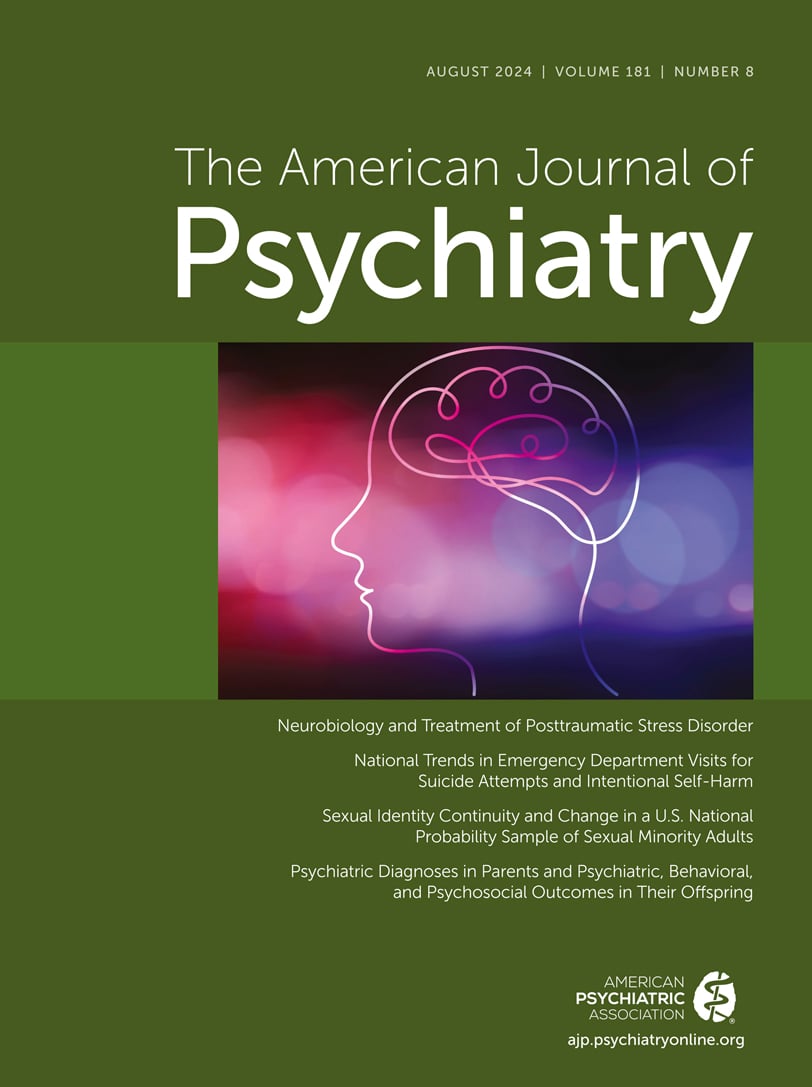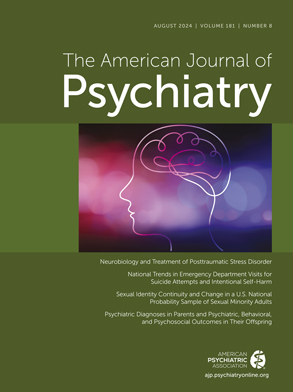Children born to parents with a mental illness have been shown, over and over again, to be at an increased risk of developing mental health problems early in life. A recent comprehensive meta-analysis that gathered data from all over the world, including data from 3 million individuals at familial risk and 20 million control individuals, left no doubt about the increased risk (
1). On the other hand, not all children with a genetic predisposition for mental illness fall ill; in fact, many of these children stay well, at least in terms of not being diagnosed.
This double aspect—that on the one hand, offspring of parents with mental illness have an increased risk, and on the other hand, many stay well—is well-documented by Zhou et al. (
2) in this issue of the
Journal based on strong data from Swedish registers. The authors’ aim was to supplement our knowledge and understanding of intergenerational transmission, not only by studying associations of parental diagnoses with rates of diagnoses and mental health issues among the offspring but also by including other behavioral outcomes, such as criminality, suicide, and aspects of psychosocial functioning, namely, school and labor performance. Six groups of parental diagnoses were defined as exposures (schizophrenia, bipolar disorder, alcohol-related disorders, drug-related disorders, depression, and anxiety), and associations with 32 outcomes among offspring, grouped in six outcome domains (psychotic-like, neurodevelopmental, internalizing, externalizing, accidents and behavior, and school and labor performance), are reported in tables and clear graphic figures. It is readily apparent that the absolute risk for all outcomes and the hazard ratios are higher for the exposed individuals—those having a parent with one of the psychiatric illnesses—compared with the unexposed individuals, up to age 44. For example, the hazard ratios for depression and PTSD across all six exposure groups are more than double those for the unexposed groups, which was also true for ADHD and alcohol use disorder, both of which were documented by diagnoses and medication data.
Mental health problems are clinically defined by diagnostic definitions according to presence of symptoms, and in clinical settings, these diagnoses are central and important. Although diagnoses are fundamental for our understanding and treatment of a given condition, when we examine people who seek help, in terms of predicting risk for transgenerational transmission, it seems that diagnoses do not matter much, at least when we look at the overall picture. Previous research has shown that offspring of parents with any psychiatric diagnosis are at increased risk of being ill themselves (
3). In the study by Zhou et al., all risk estimates were increased in all six exposure groups, and there was no evident pattern of lower levels of risk with some parental diagnoses relative to others. The only exceptions to equally increased risks across the six diagnoses were that risks for bipolar disorder and schizophrenia were highest among children of parents with bipolar disorder or schizophrenia. When meeting patients with a psychiatric diagnosis who have children, the general transdiagnostic transmission of risk is important to keep in mind, so we can provide suggestions for preventive strategies and early intervention approaches that could have an impact on the children.
Although not all children with a parent who needs and seeks treatment for psychiatric symptoms become ill, growing up in such a family almost always has an impact on family life and the family members. The home environment may be more seriously influenced during periods when the illness is active and symptoms are manifest, affecting parenting skills, the ability to provide sensitive and developmentally appropriate care, and the regularity of daily routines in the family. For most people, being a parent can be both a source of pleasure and love, but it is also a task that can be demanding, stressful, and difficult. In a large clinical, representative cohort (the Danish High Risk and Resilience study [
4–
6]), we assessed 522 children, most of whom were born to parents with schizophrenia or bipolar disorder and were recruited via Danish registers when the children were 7 years of age; these children were then thoroughly evaluated at ages 11 and 15 (data from the 15-year-old children are currently being analyzed). We learned that many aspects of family life are affected when a parent is suffering from schizophrenia or bipolar disorder. For example, we found that a greater proportion of caregivers in families with parental mental illness reported feelings of helplessness or being frightened of their child in their caregiving role, indications of what is called disorganized caregiving. Furthermore, we found that children with a familial predisposition for severe mental illness as a group reported greater exposure to traumatic life events both in middle childhood (age 7) and in early adolescence (age 11) (
7). This association remained apparent when we controlled for stressful events related directly to one parent having a mental illness (e.g., “father being hospitalized”). More children with a familial risk for mental illness, especially schizophrenia, were found to live in home environments that did not provide the level of stimulation, structure, and support that a child needs (
8,
9). These familial factors may have an impact on the children’s cognitive and psychological development, which is supported by the results of Zhou et al., because school ineligibility, low grades, and low cognitive ability were also found to be increased among all six groups of exposed children. When we looked at several domains simultaneously in our cohort study, approximately one-fifth of the children with a familial predisposition (i.e., having a parent with a diagnosis—mainly schizophrenia—in the register) had poorer results in several areas of life and were found to be at severely high risk by age 7 (
10).
It is a positive development that more focus has been given to these families and their children at risk in recent decades. Large amounts of international research have improved our understanding of risk factors, child neurodevelopment, illness etiology, and interactions between genes and environment. We now know that genes and environment interact via epigenetic mechanisms, and thus development must be understood in a more dynamic manner. Environmental factors play a central role in psychopathological development, which can be seen as positive because we as a society have the potential to influence and change the surroundings of a child who is at risk by supporting and promoting the availability of protective factors and by using the knowledge we have about risk factors for prevention. Evidence shows that early interventions work in terms of reducing risk (
11).
Furthermore, in the past decade, the impact of stigma related to mental illness has been discussed and debated more openly. Antistigma campaigns and information by the media and narratives from people with lived experiences who are offspring of parents with mental health problems have gained attention. Famous and nonfamous people have started to speak more openly about mental health issues from a child’s perspective and how it had been for them to grow up in a family where one parent suffered from a mental disorder. Many people have told their stories and asked the question, “Why didn’t anybody ask me, when I was a child, ‘How are you doing in your family?’,” indicating that some of the closest persons around the family, like neighbors, teachers, or family members, close their eyes and avoid asking the important questions. This is because of the sensitivity of the subject. Many parents may wonder how the consequences of their mental illness affect their children and worry that they might transmit the illness, but they are also afraid of being stigmatized and judged as “poor parents” (
12). Therefore, these issues must be addressed in a careful and understanding way, but at the same time, it should be part of the treatment provided for any patient who is also a parent. Although families with complex problems may need a more intensive intervention, support for psychoeducation and open communication in the family, peer groups, and parental training may be low-hanging fruits that would work for many families.

